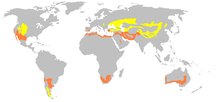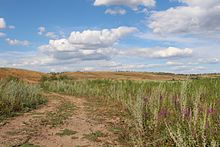Steppe
This article needs additional citations for verification. (February 2014) |






In physical geography, a steppe (/stɛp/) is an ecoregion characterized by grassland plains without trees apart from those near rivers and lakes.[1]
Steppe biomes may include:
- the montane grasslands and shrublands biome
- the temperate grasslands, savannas and shrublands biome
A steppe may be semi-arid or covered with grass or with shrubs or with both, depending on the season and latitude. The term "steppe climate" denotes the climate encountered in regions too dry to support a forest but not dry enough to be a desert. Steppe soils are typically of the chernozem type.
Steppes are usually characterized by a semi-arid or continental climate. Extremes can be recorded in the summer of up to 45 °C (115 °F) and in winter, −55 °C (−65 °F). Besides this major seasonal difference, fluctuations between day and night are also very great. In both the highlands of Mongolia and northern Nevada, 30 °C (85 °F) can be reached during the day with sub-freezing readings at night.

Mid-latitude steppes feature hot summers and cold winters, averaging 250–510 mm (10–20 in) of precipitation per year. Precipitation level alone does not define a steppe climate; potential evapotranspiration also plays a role.
Classification

Steppe can be classified by climate:[2]
- Temperate steppe: the "true" steppe, found in continental areas of the world; they can be further subdivided, as in the Rocky Mountains Steppes[2]
- Subtropical steppe: a similar association of plants occurring in the driest areas with a Mediterranean-like climate; it usually has a short wet period
It can also be classified by vegetation type, e.g. shrub-steppe and alpine-steppe.
The Eurasian Grass-Steppe, with its temperate grasslands, savannas, and shrublands, had a role in the spread of the horse, the wheel, and the Indo-European languages.[3] In the eastern Mediterranean space, for example, the Indo-European expansion and diverse invasions of horse-archer civilizations of the steppe eventually led to the rise of Mycenaean Greece by the amalgamation of Indo-Europeans with the autochthonous pre-Greek population[4] and also its destruction (sometimes attributed to the "Dorian invasion" in the Late Bronze Age collapse), followed[citation needed] by the demise of the Achaeans, the spread of the Sea Peoples,[citation needed] and eventually the rise of Archaic and ultimately Classical Greece.[citation needed]
Locations

Cold steppe
The world's largest steppe region, often referred to as "the Great Steppe", is found in Eastern Europe and Central Asia, and neighbouring countries stretching from Ukraine in the west through Russia, Kazakhstan, Turkmenistan and Uzbekistan to the Altai, Koppet Dag and Tian Shan ranges in China.
The inner parts of Anatolia in Turkey, Central Anatolia and East Anatolia in particular and also some parts of Southeast Anatolia, as well as much of Armenia and Iran are largely dominated by cold steppe.
The Pannonian Plain is another steppe region in Central Europe, primarily Hungary.

Another large steppe area (prairie) is located in the central United States, western Canada and northern part of Mexico. The shortgrass prairie steppe is the westernmost part of the Great Plains region. The Columbia Plateau in Southern British Columbia, Oregon, Idaho, and Washington state, is an example of a steppe region in North America outside of the Great Plains.
In South America, cold steppe can be found in Patagonia and much of the high elevation regions east of the southern Andes.
Relatively small steppe areas can be found in the interior of the South Island of New Zealand.

In Australia, a moderately sized temperate steppe region exists in the northern and north west regions of Victoria, extending to the southern and mid regions of New South Wales. This area borders the semi arid and arid Australian Outback which is found further inland of the continent.
Subtropical steppe
In Europe, some Mediterranean areas have a steppe-like vegetation, such as central Sicily in Italy, southern Portugal, parts of Greece in the southern Athens area,[5] and central-eastern Spain, especially the southeastern coast (around Murcia), and places cut off from adequate moisture due to rain shadow effects such as Zaragoza.
In Asia, a subtropical steppe can be found in semi-arid lands that fringe the Thar Desert of the Indian subcontinent and the Badia of the Arabian peninsula.
In Australia, "subtropical steppe" can be found in a belt surrounding the most severe deserts of the continent and around the Musgrave Ranges.
In North America this environment is typical of transition areas between zones with a Mediterranean climate and true deserts, such as Reno, Nevada, the inner part of California, and much of western Texas and adjacent areas in Mexico.
See also
- Baraba steppe
- Canadian Prairies
- Coastal plain
- California coastal prairie
- Western Gulf coastal grasslands
- Desert
- Eurasian Steppe
- Field (agriculture)
- Flooded grasslands and savannas
- Flood-meadow
- Forest steppe
- Grassland
- Great Hungarian Plain
- High Plains
- Kazakh Steppe
- Mammoth steppe
- Meadow
- Mongolian-Manchurian grassland
- Pasture
- Plain
- Pontic–Caspian steppe
- Pannonian Steppe#Pannonian steppe in Hungary – Puszta
- Rangeland
- Savanna
- Steppe Route
- Syrian Steppe
- Temperate grasslands, savannas, and shrublands
- Tugay – type of river forests related with steppes
- Tundra
- Water-meadow
- Wet meadow
- Veld
References
- ^
Compare:
Chibilyov, Alexander (2002). "Steppe and Forest-steppe". In Shahgedanova, Maria (ed.). The Physical Geography of Northern Eurasia. Oxford regional environments. Vol. 3 (reprint ed.). Oxford: Oxford University Press (published 2003). p. 248. ISBN 9780198233848. Retrieved 30 January 2020.
There are many definitions of steppes. For example, Allan (1946) provides fifty-four definitions of this term. Stamp and Clark (1979) define steppes as 'mid-latitude areas dominated by herbaceous vegetation and termed locally steppes, prairies, pampas, high veldts, downland, etc.'
- ^ a b "Ecoregions of the United States-Ecological Subregions of the United States". fs.usda.gov. U.S. Forest Service, U.S. Department of Agriculture. Retrieved 25 October 2016.
- ^
Anthony, David W. (15 August 2010) [2007]. The Horse, the Wheel, and Language: How Bronze-Age Riders from the Eurasian Steppes Shaped the Modern World (reprint ed.). Princeton: Princeton University Press (published 2010). p. 240. ISBN 9780691148182. Retrieved 12 June 2022.
[...] the critical era when innovative Proto-Indo-European dialects began to spread across the steppes.
- ^
Lazaridis, Iosif (2017). "Genetic origins of the Minoans and Mycenaeans". Nature. 548 (7666) (published 2 August 2017): 214–218. Bibcode:2017Natur.548..214L. doi:10.1038/nature23310. ISSN 1476-4687. PMC 5565772. PMID 28783727.
[...] the Mycenaeans differed from Minoans in deriving additional ancestry from an ultimate source related to the hunter–gatherers of eastern Europe and Siberia[...], introduced via a proximal source related to the inhabitants of either the Eurasian steppe [...] or Armenia [...].
- ^ "Hellinikon". HNMS.gr. Greece: Hellenic National Meteorological Service. Archived from the original on 2007-03-12. Retrieved 2013-09-08.
Sources
- Ecology and Conservation of Steppe-land Birds by Manuel B.Morales, Santi Mañosa, Jordi Camprodón, Gerard Bota. International Symposium on Ecology and Conservation of steppe-land birds. Lleida, Spain. December 2004.ISBN 84-87334-99-7
External links
- "The Steppes". barramedasoft.com.ar. 1998–2008. Retrieved 2008-04-04.
